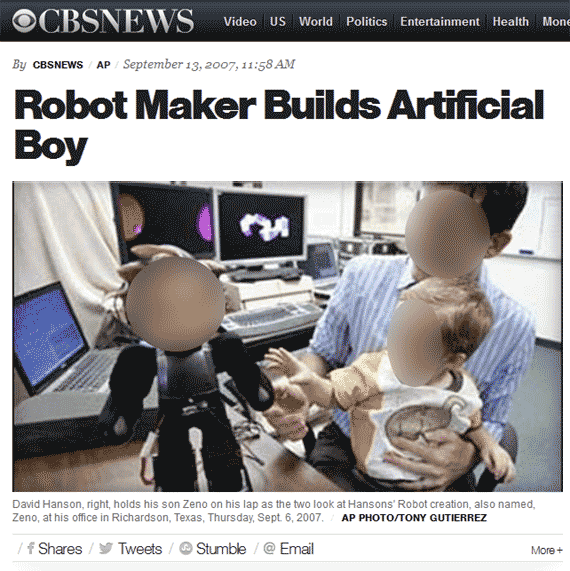AboutAtheism.Net
Posted by Abu.Iyaad on Wednesday, April, 09 2014 and filed under Articles


At 17 inches tall and 6 pounds, the artificial Zeno is the culmination of five years of work by Hanson and a small group of engineers, designers and programmers at his company, Hanson Robotics. They believe there's an emerging business in the design and sale of lifelike robotic companions, or social robots. And they'll be showing off the robot boy to students in grades 3-12 at the Wired NextFest technology conference Thursday in Los Angeles.
Unlike clearly artificial robotic toys, Hanson says he envisions Zeno as an interactive learning companion, a synthetic pal who can engage in conversation and convey human emotion through a face made of a skin-like, patented material Hanson calls frubber.
"It's a representation of robotics as a character animation medium, one that is intelligent," Hanson beams. "It sees you and recognizes your face. It learns your name and can build a relationship with you."
The company, which has yet to break even, was also buoyed by a $1.5 million grant from the Texas Emerging Technology Fund last October. The fund was created by Gov. Rick Perry in 2005 to improve research at Texas universities and help startup technology companies get off the ground. Hanson concedes it's going to be at least 15 years before robot builders can approach anything like what seems to be possible in movies. Zeno the robot remains a prototype.
During a recent demonstration, Zeno could barely stand and had to be tethered to a bank of PCs that told it how to smile, frown, act surprised or wrinkle its nose in anger.
Hanson says one of the robot Zeno's biggest advancements is that its brains aren't inside the robot. Instead Zeno synchs wirelessly to a PC running a variant of Massive Software - the same Academy Award-winning code that enabled the fantastical battles among humans, orcs and elves in the "Lord of the Rings" movies.
Hanson has been recognized for his work, garnering accolades from the Association for the Advancement of Artificial Intelligence in 2005 and a "best design" award at the Smithsonian's Cooper-Hewitt National Design Triennial last year.
Knowledge, will, power, intent, purpose, wisdom are all essential attributes and there must exist an agent possessing them to explain the presence of the robot which clearly exhibits signs of design and purpose. It is not required to explain where David Hanson came from to reason that Zeno, the Robot, had a designer and maker.